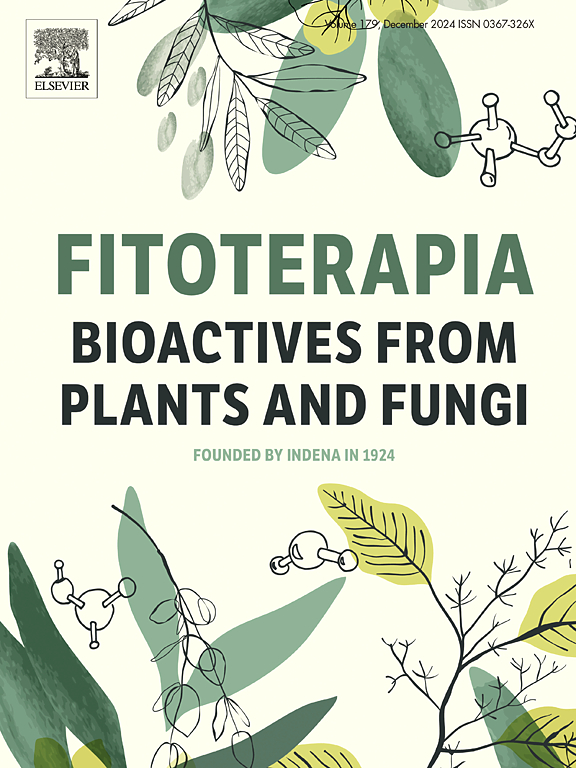Screening Withania somnifera as biostimulant for crop plants and chemical profiling of its active fractions
IF 2.6
3区 医学
Q3 CHEMISTRY, MEDICINAL
引用次数: 0
Abstract
Studies have highlighted that Withania somnifera contain endogenous molecules, with varying biological activities. In light of this, the current experiment aimed the plant growth-promoting potential of Withania somnifera leaf extract (WsLE) through seed priming. Twenty crop plants were tested to assess the bio-stimulatory effects of WsLE. The selected morphological features for evaluation included germination percentage, plant length and fresh biomass while the biochemical parameters assessed were total polyphenolic, protein, and flavonoid content, enzymatic activities: peroxidase, phenylalanine ammonia lyase and antioxidant activities. The results demonstrated that WsLE enhanced the evaluated parameters though the bio-stimulant effects varied across the crop species. Certain crop plants, such as, T. foenum-graceum, V. radiata and S.bicolor showed particularly strong responses, exhibiting marked improvements in plant growth and biochemical traits. To better understand the variability in response, Principal component analysis was conducted to categorize the crop plants according to the influence of different WsLE dilutions. Chromatographic profiling and identification of bioactive compounds in WsLE were performed using HPLC and UHPLC/HRMS. The analytical characterization revealed that the presence of 26 withanolides, 5 phytohormones and 26 other bioactive phytoconstituents. Quantitative analysis demonstrated that 27- hydroxywithanone and withaferin A exhibited the highest abundance among all identified compounds, suggesting potential role as the primary bioactive constituent. The comprehensive chemical characterization indicated that these major bioactive compounds likely serve as key modulators of physiological and biochemical pathways.

作物生物刺激素的筛选及其活性组分的化学分析。
研究表明,苦参含有内源性分子,具有不同的生物活性。鉴于此,本试验旨在通过种子引种的方法研究Withania somnifera叶片提取物(WsLE)对植物生长的促进作用。对20种作物进行了试验,以评估WsLE的生物刺激效应。形态学指标包括发芽率、株长和新鲜生物量,生化指标包括总多酚、蛋白质和类黄酮含量,酶活性:过氧化物酶、苯丙氨酸解氨酶和抗氧化活性。结果表明,尽管不同作物的生物刺激效应不同,但WsLE对评价参数有增强作用。某些作物,如T. foenum-graceum、V. radiata和S.bicolor的反应尤其强烈,在植物生长和生化性状方面表现出明显的改善。为了更好地了解响应的变异性,采用主成分分析方法,根据不同WsLE稀释度的影响对作物进行分类。采用高效液相色谱法(HPLC)和高效液相色谱法(UHPLC/HRMS)对其进行色谱分析和活性成分鉴定。分析鉴定结果表明,该植物中含有26种植物内酯类化合物、5种植物激素和26种其他生物活性成分。定量分析表明,27-羟基withanone和withaferin A在所有鉴定的化合物中丰度最高,表明其可能是主要的生物活性成分。综合化学表征表明,这些主要生物活性化合物可能是生理生化途径的关键调节剂。
本文章由计算机程序翻译,如有差异,请以英文原文为准。
求助全文
约1分钟内获得全文
求助全文
来源期刊

Fitoterapia
医学-药学
CiteScore
5.80
自引率
2.90%
发文量
198
审稿时长
1.5 months
期刊介绍:
Fitoterapia is a Journal dedicated to medicinal plants and to bioactive natural products of plant origin. It publishes original contributions in seven major areas:
1. Characterization of active ingredients of medicinal plants
2. Development of standardization method for bioactive plant extracts and natural products
3. Identification of bioactivity in plant extracts
4. Identification of targets and mechanism of activity of plant extracts
5. Production and genomic characterization of medicinal plants biomass
6. Chemistry and biochemistry of bioactive natural products of plant origin
7. Critical reviews of the historical, clinical and legal status of medicinal plants, and accounts on topical issues.
 求助内容:
求助内容: 应助结果提醒方式:
应助结果提醒方式:


